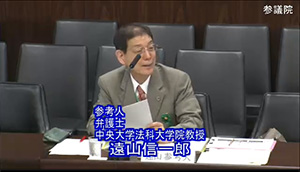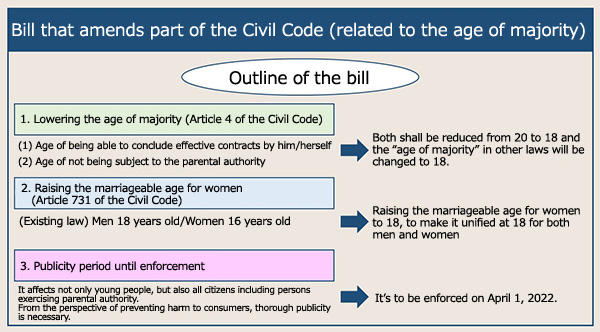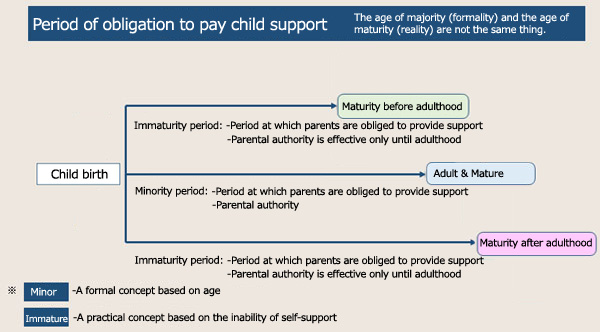Top>Research>Staircase to Adulthood
 Index
Index
Staircase to Adulthood
-Consideration to the Issue of the Lowering of Age of Majority (Article 4 of the Civil Code)-
Shinichiro Toyama
Professor, Chuo Law School, Member of Daiichi Tokyo BAR Association
Areas of Specialization: Corporate Compliance, Modern Contract Law, Tort and Compensation Law (traffic accidents, medical malpractice, nuclear accidents, etc.), Domestic Relations Case Procedure Act, Labor Law, Insolvency Proceeding Law, Financial Legal Affairs, Antitrust Law, Personal Information Protection Law, Alternative Dispute Resolution (ADR), Legal Economics
1. At the House of Councillors Committee on Judicial Affairs

As requested on June 7, 2018, I have provided my referential opinion about the bill that amends part of the Civil Code (Act No. 55 presented by the Cabinet) proposed in the 196th Plenary Session of the Diet, House of Councillors Committee on Judicial Affairs (Chairman Hirotaka Ishikawa).
So, I would like to present the summary of my opinion.

2. Expansion of fully participating members of civil society
Lowering the age of majority will mean an increase of qualified “civil society’s full participators,” that is, independent and autonomous family members, consumers, workers, and enterprises, who are the “civil society’s trunk.”
On the other hand, it can be said that raising the elderly age would exert a similar effect.
Due to the declining birthrate and aging population in Japan, the demographic structure is shifting from a pyramid shape to a coffin shape. In such circumstances, it can be said that it’s an unavoidable policy to increase the workforce of the society.
Moreover, improving the robustness (achieving practicality) of “civil society’s trunk” requires supportive measures to allow the immature majority (Adult ≠ mature) to become independent and autonomous enough. For example, Evidence Based Policy Making (EBPM) can be said to be essential in our country, such as establishing a system for equal opportunity of advanced education and the environment to develop young people’s ability to be autonomous (ability to be fully participating members).

3. Downward spiral hypothesis: correlation with children’s poverty problem
1. Let me set a hypothesis on the negative influence of lowering the age of majority on children in the figure below.

Regarding the spiral hypothesis, various statistical data indicate that it is difficult to prove a causal relationship, however a correlation is sufficiently recognized.
2. It is said that the major cause of children’s poverty is the poverty of single parent families (especially single mother families). In order to support single parent families, the government is implementing comprehensive measures based on the four pillars: childrearing and daily life support, employment support, measures to ensure child support, and economic support.
In this way, “measures to ensure child support” is viewed as a supporting pillar.
3. As for child support in case of a divorce, problems such as “no arrangement has been decided,” “even if arrangements were made, it would be a low amount,” and “regardless of the arrangement, payment won’t be made” have always been unsettled leaving a lot to be done. On top of that, lowering the age of majority has a risk of shortening of the paying period of child support, so there are concerns that the already insufficient child support might get even less.

Children cannot choose their parents. Therefore, they must be guaranteed equal rights of receiving sufficient education regardless of their birth environment. Thus, it’s strongly desired that the country opens up the way for educational paths closed by their parents.
Therefore, practical and institutional endeavors to avoid that risk are desired. It can be said that it’s necessary to promote the paradigm shift from the age of “don’t let law come between family members” to a new age of “let law rule even families,” through the organizational enhancement and functional expansion of family courts, which are the guardian deity of families (judges, conciliation committee members, research law clerks, etc.), and institutional expansions to help secure child support by designing a system through which the government decides the minimum amount and obliges parents with its fulfillment, etc.
4. Eliminating concerns as seen in supplementary resolution
The House of Councillors Committee on Judicial Affairs has set a detailed supplementary resolution of countermeasures to the various concerns that the lowering of age of majority brings along.
The points related to my referential opinion is as below:
From the perspective of supporting the independence of young people who are 18 and 19 years old, measures that take into consideration the following points before the implementation of said law shall be taken.
- Take necessary measures, such as confirming that the age of majority and the payment period of child support are not linked and each parent has a duty to pay their share of child support as long as the child is not mature, and making the methods of agreeing on child support well known, in order to provide single parent families with financial security for child support.
- As for the standards for calculating the child support that corresponds to the current socioeconomic situation, cooperate with the research and investigation conducted by the court.
- Considering the fact that young people who are 18 and 19 years old have different levels of maturity or live in a different environment, we shall take necessary measures to support development and growth of such individuals (especially to ensure that supporting their independence in accordance with the Child Welfare Act is not stagnating).
The number of steps of the staircase to adulthood is directly connected with education, child welfare, and consumer issues, making it a true multidimensional issue.
The bill was passed at a plenary session of the House of Councillors dated June 13, 2018.
Now that the age of majority has been changed to 18 in the Civil Code, the healthy development of youths more than ever is possibly the mission possible that requires each and every one of the people (the entire society) to earnestly take up with an awareness of the issue.
References
- Shinichiro Toyama, Duty of Support Towards Minors, (the liberty & justice, January 2010 issue, pp. 65-68)
- Family Welfare Division of the Child and Family Policy Bureau, the Ministry of Health, Labour and Welfare, Regarding Support to Single Parent Families, April 2018
- The Yomiuri Shimbun, To Become an 18-Year-Old Adult 2: Child-rearing Expenses Decide the Path to Higher Education—Don’t Want My Parents to Get in My Way, Evening Edition, November 25, 2016
- Noriko Mizuno, Lowering Age of Majority from the Perspective of Civil Code, (Jurist vol. 1392 pp. 162-167, 2010)
- The Nikkei, Are Adults 20 or 18, Evening Edition, December 4, 2008
Related links:
- Internet relayed deliberation of House of Councillors Committee on Judicial Affairs opened June 7, 2018
- The Two Basic Laws of Life-Family Law and Labor Law-
- Scenes from Law School and Business School
- Happiness Equation for Workers―From the Perspective of Compliance for Increasing Corporate Value―
- How to Survive in a Contractual Society ― The Great Heisei Civil Code Reform (Credits-Related Civil Code Amendments) ―
- Shinichiro Toyama
Professor, Chuo Law School, Member of Daiichi Tokyo BAR Association
Areas of Specialization: Corporate Compliance, Modern Contract Law, Tort and Compensation Law (traffic accidents, medical malpractice, nuclear accidents, etc.), Domestic Relations Case Procedure Act, Labor Law, Insolvency Proceeding Law, Financial Legal Affairs, Antitrust Law, Personal Information Protection Law, Alternative Dispute Resolution (ADR), Legal Economics -
After graduating from the Department of Law in the Chuo University Faculty of Law in 1975, Shinichiro Toyama became a Specially Appointed Professor in the Chuo Law School in 2004. He has served as Professor in the Chuo Law School since 2014 to the present.
He lectures on modern contract law at the Business School of Chuo University.
His major public positions include a member of a special committee of the Dispute Reconciliation Committee for Nuclear Damage Compensation of the Ministry of Education, Culture, Sports, Science and Technology; a member of a special committee of the Dispute Reconciliation Committee of Construction Work of the Ministry of Land, Infrastructure, Transport and Tourism; a member of the Civil Conciliation Commissioners of the Supreme Court of Japan; a director of the Japan Center for Settlement of Traffic Accident Disputes; a medical ADR arbitrator for the Tokyo San Bengoshikai and more.
He serves as Research Director for the Grants-in-Aid for Scientific Research (JSPS KAKENHI Grant Number 15K03220).
His main publications and articles include Antitrust Law Useful for Daily Living, The World of Traffic Accident Civil Liability: Theory and Practice, Resolution of Individual Labor Disputes, Child Welfare and Joint Custody, JA Compliance: Creating a System for Preventing Misconduct, Construction Process Theory of the Corporate Value Improvement Type Compliance Preparation Model and more.
He is a regular contributor in the Monthly JA (JA-ZENCHU) magazine where his column is entitled How to Survive in a Contractual Society. Other writings include: Introduction to Modern Contract Law (2015), Modern Contract Law in Practice: Techniques of Producing Contracts (2016), Modern Contract Law: Labor Contracts (2017), and Modern Contract Law: Summary of Civil Code (Liability-Related) Amendments (2018).
- Research Activities as a Member of Research Fellowship for Young Scientists (DC1), Japan Society for the Promotion of Science (JSPS) Shuma Tsurumi
- Important Factors for Innovation in Payment Services Nobuhiko Sugiura
- Beyond the Concepts of Fellow Citizens and Foreigners— To Achieve SDGs Goal 10 “Reduce Inequality Within and Among Countries” Rika Lee
- Diary of Struggles in Cambodia Fumie Fukuoka
- How Can We Measure Learning Ability?
—Analysis of a Competency Self-Assessment Questionnaire— Yu Saito / Yoko Neha - The Making of the Movie Kirakira Megane









